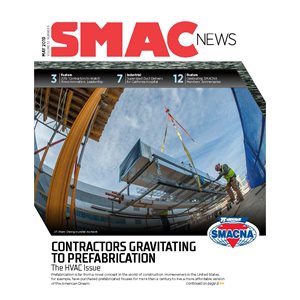Saving the Hardest for Last
In a construction-related business of any size, decisions come early and often, particularly when you are the owner.
In a construction-related business of any size, decisions come early and often, particularly when you are the owner. As the scope of your leadership role expands, the decisions usually only get harder because all the easier decisions are made by other people! Initially, many decisions feel daunting because you have no frame of reference. But with time, some decisions get easier because you have the experience of past mistakes and successes to guide you.
But life has a way of handing us the very hardest decisions at the very end of our careers. Few of us will have any relevant experience to draw from. While the counsel of others will be valuable, these end-of-career decisions are intensely personal and require a leader’s lifelong accumulation of wisdom, resolve, and courage to make. These decisions are of ultimate strategic importance, but don’t feel urgent until it’s almost too late. I’m talking about decisions regarding what we think of as retirement.
“Retirement” is an inadequate social construct based on outdated actuarial tables and work demands. When the Social Security Act was passed in 1935 guaranteeing retirement pensions to all Americans over the age of 65, the average life expectancy was less than 62 years!
Today most people can expect around 20 plus years of productive living past that age. Many of our clients are actively engaged in their business long past 65. They enjoy the work itself, the thrill of accomplishment, as well as the financial rewards it provides. The only drawback is that past 65, the odds only increase that some external circumstance (illness, family complications etcetera) will force a decision we aren’t prepared to make. That’s why these hardest decisions still need to be made, before some unforeseen crisis makes it for us.
When do I step away?
This may be the hardest and most crucial decision we ever make. Leave too soon and the company will be weakened and unprepared for a future without you. Hold on to long and you can become an anchor working against the sails of the next generation, regardless of intent. There are many other difficult decisions that follow, but establishing a realistic timeline is where all these begin.
Who will take my place?
By the time you’ve been in leadership for a few decades, the job you’re doing is uniquely built around your skills and aptitudes, likes and dislikes, and personal preferences. There is no one individual in your organization who has that same profile. That means in most cases, replacing your scope of responsibility will necessitate a group of people. Understanding that early will save some costly misfires.
Where will I reinvest my life going forward?
One of the roadblocks to making these first two decisions is the lack of thought around how you plan to purposefully live in your next chapter. Recreation is great, but when you can golf/fish/travel, whenever you want, it very often loses its appeal. Conducting a simple audit of time and energy will usually reveal a leader’s significant lack of diversity in their time/energy portfolio. Right now, it’s likely that most/all of your meaningful relationships, sense of purpose, source of satisfaction and your very identity are wrapped up in your business.
Untangling these essentials of happiness from your current role is a primary prerequisite for discovering your preferable future!
Published: May 20, 2019
IN THIS ISSUE
2019 'Contractors to Watch’ Stress Innovation, Leadership
This feature showcases a select group of SMACNA contractors who are making a difference and having a positive impact in their local areas, whether through innovation, engagement or expansion.
Capitol Hill Update - A SMACNA Priority: Contract Change Order Reform Introduced in Congress
Due to its popularity with contractors nationwide, federal change order reform has recently been reintroduced in Congress. It has bipartisan support and a promising future of passage.
Celebrating SMACNA Members’ Anniversaries
While SMACNA National celebrates its 75th anniversary this year, there are many members and chapters who are also commemorating their own noteworthy milestones. We will share just a few of their milestones and their philosophies, humble beginnings
Contractors Gravitating to Prefabrication for Sheet Metal and HVAC Projects
Prefabrication is far from a novel concept in the world of construction. Homeowners in the United States, for example, have purchased prefabricated houses for more than a century to live a more affordable version of the American Dream.
IFS Helps Upgrade Missouri Schools to Reduce Energy Costs
Integrated Facility Services (IFS) of St. Louis, Missouri is a key player in the St. Louis County Pattonville School District’s $10.2 million dollar energy conservation project to upgrade the schools’ aging facilities and save on energy costs.
ITI Strike Force Training Focuses on Intricate Wall Panel Systems
As building envelope designs become more complex, so does installing their intricate wall paneling systems. Architects and design professionals are increasingly calling for the latest in-demand wall paneling systems.
Prefabrication Speeds Installation in Dormitory Spaces
Over the past several years, James Morgan, president and CEO of Worcester Air Conditioning, Ashland, Massachusetts, estimates that his sheet metal workers have prefabricated and installed ductwork in more than 3,000 dormitory rooms in colleges and
President’s Column: Developing Our Strengths by Learning from Each Other
How do we improve the way we work in our shops? How do we know what works and what doesn’t, what new shop technologies to test and what not to waste our time on, and what’s a good investment and what should we avoid at all costs?
Saving the Hardest for Last
In a construction-related business of any size, decisions come early and often, particularly when you are the owner.
SMACNA Contractor’s Supersized Duct Delivers for California Hospital
The Sutter Women’s and Children’s Hospital project in Sacramento, California, was headed for disaster in the preconstruction phase in 2009. SMACNA contractor Air Systems Service and Construction (ASSC) of Sacramento was part of the winning team when


